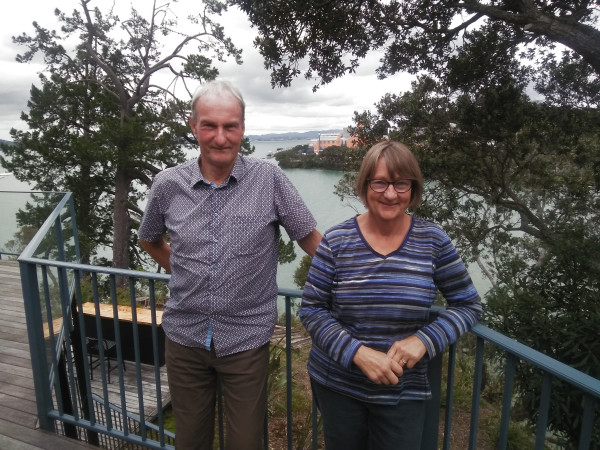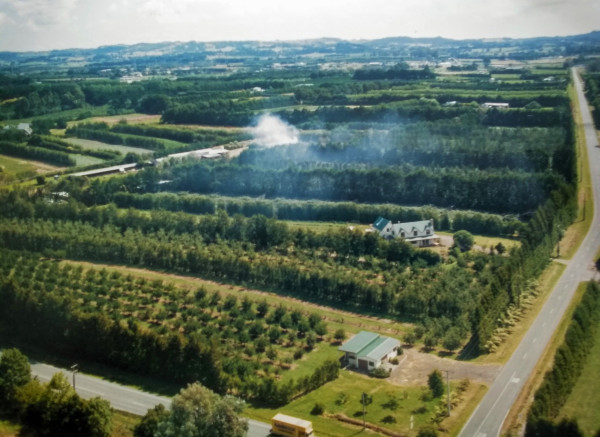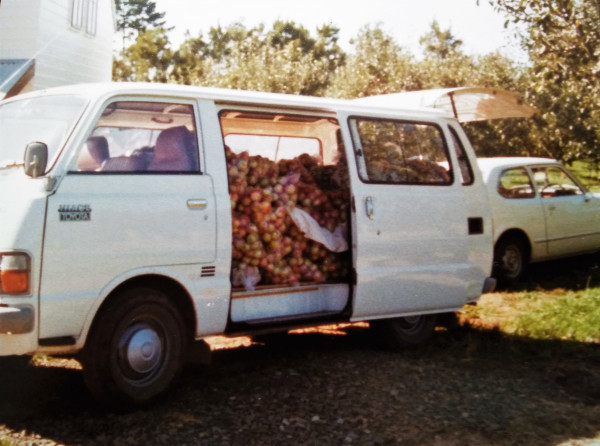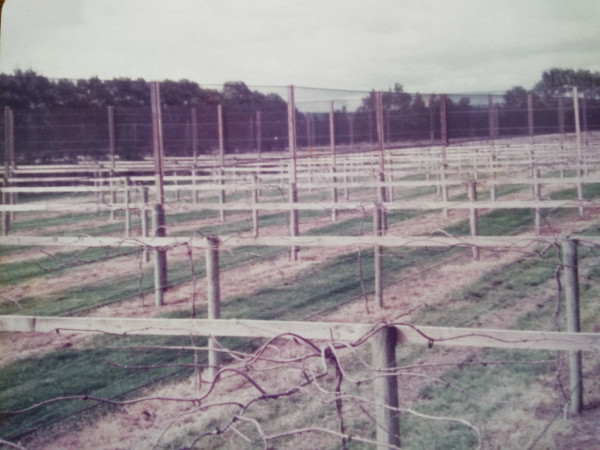Retiring growers share rich history of fruit growing
16 February 2023
After 43 years of growing pipfruit, stonefruit and then kiwifruit at Kumeu, northwest of Auckland, Richard and Sheila Mandeno have hung up their boots. As the couple settle into retirement, they reflect on how far their business has come, as well as the future prospects of the industry. GLENYS CHRISTIAN reports.

Richard and Sheila Mandeno are hanging up their gumboots after more than 40 years growing fruit in their Kumeu orchard
Richard Mandeno was brought up on a sheep and beef farm at Orere Point, southeast of Auckland.
“I always had a love of plants and growing things,” he says.
So, he joined New Zealand Forest Products – the country’s largest industrialised company at the time – as part of a forestry management cadetship based in Tokoroa.
“We were so lucky to have the opportunity to learn management skills because we were paid to study, then we worked for the company in the holidays to learn about all the various aspects of plantation forestry,” Richard says.
The 1980s marked several large milestones in Richard and Sheila’s lives, including their marriage and first exposure to horticulture at a time when the industry was booming nationwide.
Richard returned from his overseas experience (OE) in 1979 and had the opportunity to buy a 6.6-hectare horticultural block on Old Railway Road in Kumeu. The block was already established as a pipfruit and stonefruit business, selling fruit at the gate and ‘pick your own’ to the public.
Originally the property had five neighbours, all involved in fruit production of some sort, including Cooks New Zealand Wine Company. Richard joined the Independent Fruit Marketers (IFM) who were a group of Northwest Auckland pipfruit growers supplying bagged apples to multiple retail outlets and cooperatives of families interested in purchasing orchard fresh, tree-ripened apples.
Those were the days when the NZ Apple & Pear Inc Marketing Board controlled the sale of both the domestic and export crops.
“We used to play cat and mouse with the board inspectors,” Richard says.

A historic photo of Richard and Sheila’s kiwifruit establishment on Kumeu orchard
It was also a time when many new kiwifruit orchards were established in the district. Some were speculative and promoted to city professionals for tax efficiency, but a core group of kiwifruit growers that remain in business today were based in this “Golden Triangle” – a section of land bordered by the Riverhead Coatesville Highway, Old Railway Road, and Old North Road – where the peaty loam soil had proven to grow kiwifruit very well.
Unfortunately, the block’s stonefruit never quite thrived like other crops without the necessary winter chilling. So, from the 1980s onwards, the Mandenos made the decision to convert the four hectares of stonefruit to Hayward green kiwifruit; building all the pergola structures to support the vines and installing the irrigation system and artificial shelter themselves. The result was an orchard with consistently high productivity with adaptive new vine management initiatives.
The business progressively switched out its apple varieties too, to keep up with consumers’ choice of newer varieties. The final apples they had planted were the Fuji and Splendour varieties until the paddocks were converted for grazing cattle.
Richard and two other Kumeu growers established the Rodney Cooperative Packhouse (Rodpak) in Riverhead in 1983 along with around 50 other growers, enabling locally grown fruit to be packed and coolstored within the district. It operated for 15 years until production from the shareholders decreased, and remaining growers had their fruit packed in Franklin or the Bay of Plenty.
As the industry grew, so too did overseas marketing of kiwifruit. Seven exporters were licensed by the Kiwifruit Marketing Licensing Authority in the 1980s, often competing just on price.
Richard remembers meeting Fruitfed export manager, Mack Nicol, in Europe where he was shown around the fruit wholesale market in London and Belgium. He says as an observing grower, the message was clear.
“We as growers were cutting our own throats by having multiple exporters because buyers played off exporters on price, knowing the packed quality of the fruit was consistent to all exporters,” Richard says. “Having multiple sellers of New Zealand kiwifruit in the markets wasn’t working, whereas a single desk marketing body controlled by growers would better serve the industry.

Back in the day. Apples bagged and ready to be sold on the Auckland market
“I came away from those meetings thinking that our real competitors were from fruit grown in Chile, France or Italy; not fruit grown by my Kumeu neighbour who supplied his fruit to another exporter.”
The issue came to a head when growers ended up owing $2.50 for every tray of kiwifruit exported during the 1987 export season.
“The multi-seller approach wasn’t working,” Richard says. “We were bleeding and there was a lot of grower attrition.”
Richard was elected as one of the four representatives on the NZ Fruitgrowers Federation Kiwifruit Sector Committee. Its chairman was Paul Heywood. The committee organised a series of meetings around the kiwifruit growing regions of the country with the aim of obtaining 75 percent grower support for establishing a single desk marketing authority. The Minister of Agriculture agreed the government would enact legislation to establish that structure.
“It was a case of getting the Bay of Plenty on board,” Richard says. “Leo Mangos, the Bay of Plenty NZ Fruitgrowers director, played a pivotal role in achieving grower support.”
Growers voted in favour of the single desk structure for their industry and the Kiwifruit Marketing Board was set up.
Richard believes its value was seen in the industry’s resilience following the discovery of Pseudomonas syringae pv actinidiae (Psa) in the then Gold variety. Growers collectively garnered the support of banks and other institutions to ride out the devastating impact and pivot to the newer G3 or G9 varieties of SunGold.
“Other countries growing kiwifruit varieties have not had that united ability to overcome adversities like Psa,” Richard says.
Looking back, he and Sheila say they should have moved to growing Gold kiwifruit.
“But we stuck with what we’d grafted and upgraded males and adopted new management technologies,” Richard says.
This led to their block producing an average of 13,800 trays per hectare last season.

A historic photo of Richard and Sheila’s kiwifruit establishment on Kumeu orchard
In 1994 Richard re-entered the forestry industry, leasing out the orchard to EastPack. Despite a shift back to forestry, Richard and Sheila maintained their involvement with kiwifruit. They believe obtaining labour for kiwifruit orchards will be an ongoing problem for the sector. Richard and Sheila used a South Auckland contractor who would usually have a picking gang of from 20 to 25 on the orchard in April. But this year only eight to ten turned up, many with no picking experience, which they identify as a contributing factor to this year’s fruit quality problems.
“It’s an Achilles heel for the industry,” says Richard.
He points to the $700,000 per hectare cost for growers to buy new plant variety licenses only to not be able to get work carried out at the optimum time.
“Packhouses can mechanise, but winter pruning has to be done by hand at the correct time.”
Another big issue is the pressure of urban sprawl around Auckland, which has seen their now former neighbours grow to 13 in number. All are required to be advised before any spraying operation occurs and there have been reverse sensitivity issues where newcomers questioned whether using a helicopter to prevent frost damage overnight was really necessary.
“They said that wasn’t what they moved to the country to be awoken [by] at 4am,” Richard says.
The amount of commuter traffic passing by their property daily has grown rapidly, and with large truck and trailer units no longer being able to be loaded at the roadside, a new entrance and turning area had to be made within the property.
The Mandenos see both sides of the argument as while growers might not want to see more development, landowners are making the willing choice to sell to buyers wanting their land.
Another issue faced was water allocation from an aquifer below the orchard which they used for spring and summer irrigation. Maintaining the resource consent under which the water could be taken was expensive, but recently Auckland Council decided to cap the amount of water used at a lower level, so more was available for city supplies.
Looking forward, they see climate change will present more issues for kiwifruit growers around Auckland, without winter chilling for bud burst and increasing resistance to the use of chemicals. Pest and disease problems could also increase, especially with the airport and the Ports of Auckland being so close.
“Biosecurity New Zealand does a wonderful job, but Auckland growers really are on the front line.”
Originally published in the February 2023 issue of the Orchardist magazine
